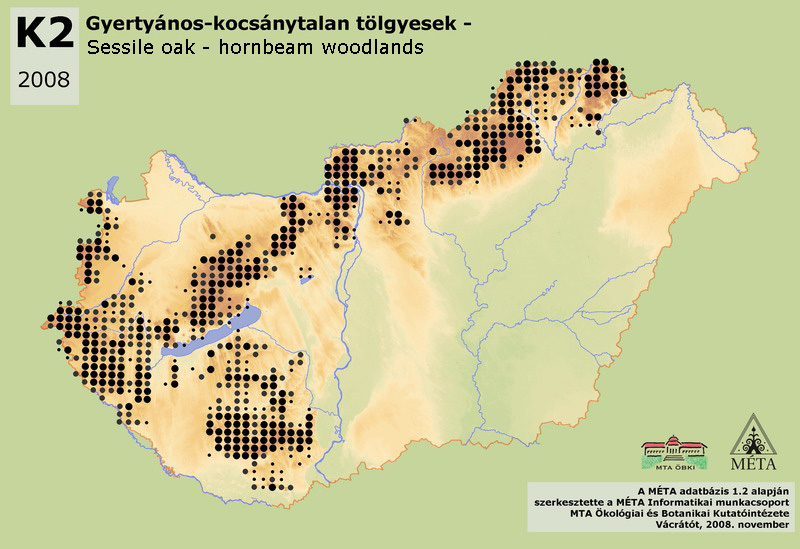MÉTA Program >>> Habitat distribution maps


K2 – Sessile oak - hornbeam woodlands:
Montane and colline, mesic, mixed forests usually on deep soils, dominated by Quercus petraea, hornbeam and/or beech. In the tree layer Tilia species may appear with high, Acer species and Fraxinus excelsior with lower ratio. The forest is characteristically shadowed, but sunny patches are usual also (their ratio is highly variable). The shrub layer is usually not dense. Most common species of the herb layer are the general and the mesic forest species. This habitat has the largest area (almost 175000 ha) in Hungary. Common in all submontane and colline regions, but it is missing from the lowlands. With largest extension (80000 and 40000 ha) it occurs in the Északi-középhegység and in the central part of Dél-Dunántúl (it is practically missing from Belső-Somogy, where it is replaced by lowland oak-hornbeam forest). It can be found with relatively smaller area on Nyugat-Dunántúl (27000 ha), and in the Dunántúli-középhegység (25000 ha). Oak-hornbeam woodland is connected to cool-humid climate suitable for mesic forests. It occurs in all type of (but mainly on solid) bedrock. In hilly regions it can rather be found on loess or loess-like sediments. It is missing on sand, but occurs on clay, where it forms mosaic with lowland oak-hornbeam woodlands (K1a). The separate documentation of the two hornbeam dominated woodland types is often not easy. Furthermore, due to the frequent selection against hornbeam, it is often problematic to differentiate it from turkey oak-sessile oak woodlands (L2a).
Molnár, Zs., M. Biró, J. Bölöni & F. Horváth (2008): Distribution of the (semi-)natural habitats in Hungary I.: Marshes and grasslands, Acta Botanica Hungarica 50 (Suppl): 59-105. >>> letöltés (5,4 MB, PDF)
MÉTA Program,
MÉTA Fotótár
MÉTA Élőhely-Ismereti Útmutató (ÉIÚ),
MÉTA Adatlap-Kitöltési Útmutató (AL-KÚ)
(C) MÉTA Informatika, 2005-2009,
MTA Ökológiai és Botanikai Kutatóintézete
K2 - Sessile oak - hornbeam woodlands - Gyertyános-kocsánytalan tölgyesek (HU)
Attachment
KV_EH_k2_elterjedes_2.0.jpg 186.69 KB